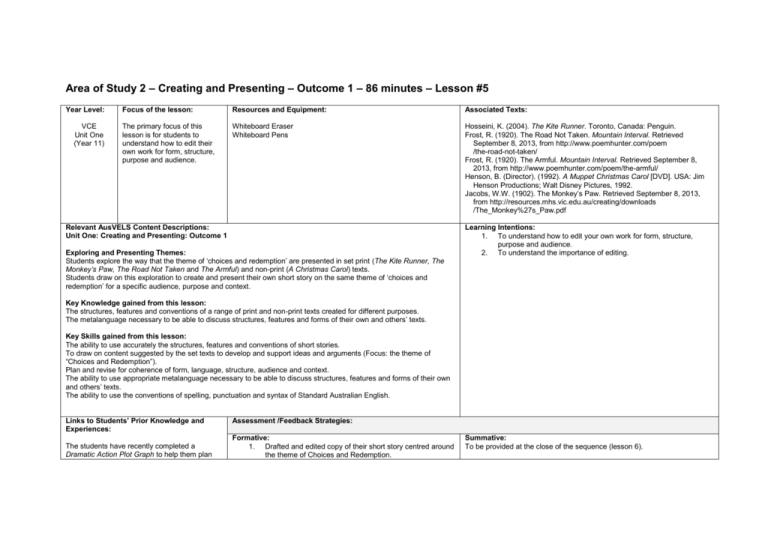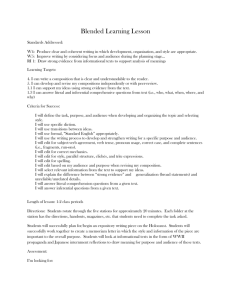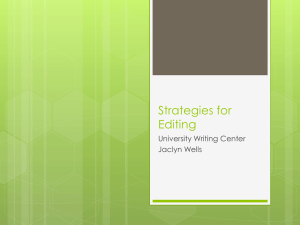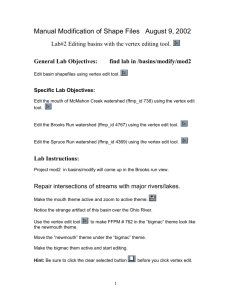Lesson 5 - 30044566
advertisement

Area of Study 2 – Creating and Presenting – Outcome 1 – 86 minutes – Lesson #5 Year Level: VCE Unit One (Year 11) Focus of the lesson: Resources and Equipment: Associated Texts: The primary focus of this lesson is for students to understand how to edit their own work for form, structure, purpose and audience. Whiteboard Eraser Whiteboard Pens Hosseini, K. (2004). The Kite Runner. Toronto, Canada: Penguin. Frost, R. (1920). The Road Not Taken. Mountain Interval. Retrieved September 8, 2013, from http://www.poemhunter.com/poem /the-road-not-taken/ Frost, R. (1920). The Armful. Mountain Interval. Retrieved September 8, 2013, from http://www.poemhunter.com/poem/the-armful/ Henson, B. (Director). (1992). A Muppet Christmas Carol [DVD]. USA: Jim Henson Productions; Walt Disney Pictures, 1992. Jacobs, W.W. (1902). The Monkey’s Paw. Retrieved September 8, 2013, from http://resources.mhs.vic.edu.au/creating/downloads /The_Monkey%27s_Paw.pdf Relevant AusVELS Content Descriptions: Unit One: Creating and Presenting: Outcome 1 Exploring and Presenting Themes: Students explore the way that the theme of ‘choices and redemption’ are presented in set print (The Kite Runner, The Monkey’s Paw, The Road Not Taken and The Armful) and non-print (A Christmas Carol) texts. Students draw on this exploration to create and present their own short story on the same theme of ‘choices and redemption’ for a specific audience, purpose and context. Learning Intentions: 1. To understand how to edit your own work for form, structure, purpose and audience. 2. To understand the importance of editing. Key Knowledge gained from this lesson: The structures, features and conventions of a range of print and non-print texts created for different purposes. The metalanguage necessary to be able to discuss structures, features and forms of their own and others’ texts. Key Skills gained from this lesson: The ability to use accurately the structures, features and conventions of short stories. To draw on content suggested by the set texts to develop and support ideas and arguments (Focus: the theme of “Choices and Redemption”). Plan and revise for coherence of form, language, structure, audience and context. The ability to use appropriate metalanguage necessary to be able to discuss structures, features and forms of their own and others’ texts. The ability to use the conventions of spelling, punctuation and syntax of Standard Australian English. Links to Students’ Prior Knowledge and Experiences: The students have recently completed a Dramatic Action Plot Graph to help them plan Assessment /Feedback Strategies: Formative: 1. Drafted and edited copy of their short story centred around the theme of Choices and Redemption. Summative: To be provided at the close of the sequence (lesson 6). their short story. Last lesson they began to draft their short story. 1. 2. 3. Edited copy of their short story centred around the theme of Choices and Redemption. Finalised copy of their short story centred around the theme of Choices and Redemption. A written exegesis explaining their short story as well as its audience, purpose and context. Lesson Sequence What will I do? What will students do? Orient Welcome students. Write the learning intentions on the whiteboard. Discuss the learning intention with the students. Explain the Agenda: 1. Students will be finishing their short stories in this lesson. 2. When finished students are to edit their own work. Students are working to understand how to edit their own work for form (short story), (narrative) structure, purpose (to deal with the theme of Choices and Redemption) and audience (as chosen by student). 3. In the next class students will be finalising their stories (creating a clean, edited copy) and writing their exegesis. Students to come in and sit down quietly. Engage Key Activity: Open discussion Discussion Key Questions: 1. Is anything changing from your plan as you write? 2. Why does this happen? 3. Are the changes you’re making good or bad? Students are to discuss: If anything has changed while they have been writing their short stories. If there have been changes, whether or not those changes align with the plot. Whether or not the changes are worthwhile and can still lead the plot through to the same climax and conclusion. Why these changes occur. Teaching Strategy: Transparent Learning Purpose: The purpose of this activity is to get students to analyse their short stories as they are writing them, to get them to think about the process of writing. It is important that students begin to understand how the writing process can easily move away from the initial plan and how authors need to decide whether or not to return to the original plan or if the changes being made are worthwhile. Completion of Short Story: Students are to be given time to finish their short stories. Time allotted for this should be approximately 20-30 minutes. Advise students of time restraint and consistently update them on the time left. Transform and Extend Advise students: Also write on whiteboard. Students are to finish their short stories in the allotted time. Having finished their short stories students are to use their prior worksheets Key Activity: Editing their own work. 1. 2. Teaching Strategy: Assessment Task Part 1 3. 4. Purpose: The task of editing their own short story falls directly to the students. The facilitator may assist in anyway to ensure students are learning how to edit correctly. This task cannot, however, be a peer-based task as this is assessable. Reflect and Evaluate 5. They will now edit their short stories using a red pen. Any markings on their short stories should be clear and easy to read. Students are to edit their own work. Students are to edit their work for form, structure, purpose and audience. Students should use their story planning sheets to do this. Redefine the words: form, structure, purpose and audience with the students. Place the definitions on the whiteboard. Students are to define the meaning of the listed words so that they are clear on what they need to be editing for. Students are to edit their work on their own with a red pen. The facilitator is to guide a discussion that clarifies for the students why editing is important. Key Questions: 1. Was it easier to edit using your worksheets as a guide? 2. Did anything change? Why did it change? 3. What is the purpose of editing? The facilitator should encourage students to offer any other ideas about editing that they have had throughout the process. Remind students that next class they will create a clean copy taking into consideration the editing changes that they have made. Students will also be writing an exegesis (written explanation) of what they have written and why. Observations and notes for next lesson: to edit their stories for form, structure, purpose, audience, context and general spelling and punctuation. Having finished editing their short stories students should now know: 1. Work changes as we write. 2. When editing we find mistakes and can fix them. 3. Work can change again when we edit. 4. We edit to ensure that our form, structure, purpose, audience, spelling, grammar and punctuation are all smooth, and correct. At a minimum, these are the things students should now understand about the editing process. Students are to offer any other insights into the process that they have discovered.





